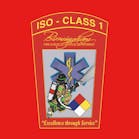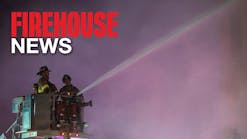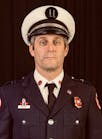A little after 8 A.M., warehouse workers were busy loading wooden cases filled with powdered magnesium into the building’s freight elevator. A number of the cases were stacked on the sidewalk adjacent to the opened elevator. Despite the fact that the air was still relatively cool, the workers were building a good sweat as they moved the heavy crates into the building. The huge warehouse, which ran through to the next block, contained large quantities of combustible materials. Stored in thebasement and on the various floors were crates of photographicflashlight powder, bonded whiskey, tons of rubber and quantities of rolled paper.
For some unknown reason – maybe a spark caused by friction – one of the cases of magnesium powder suddenly exploded, throwing several of the workers across the cobblestone street. Scrambling to their feet, they were horrified to see flames spreading among the stacked wooden crates. Most of the workers ran for their lives, while several brave men dashed back toward the fire and tried to smother the flames with pails of sand.
The sand had no effect and the fire spread from the crates on the sidewalk to those in the freight elevator. A second explosion toppled the remaining workers and spread the flames to other parts of the warehouse. A Greenwich Avenue merchant watching the activity from his store across the street decided he’d better call for help. He hurried to the nearest fire alarm box and pulled the handle.
At 8:15 A.M., the alarm was received in the Manhattan Fire Dispatcher’s Office. The first firemen to arrive found that the flames were already out of control. The wooden crates of magnesium powder were burning briskly on the sidewalk, spewing fountains of white sparks. The fire was roaring up the open elevator shaft of the seven-story building.
One after another, fire engines descended on the scene with wailing sirens. The engines stopped at hydrants, where the men quickly connected to the water supply. Hoselines were dragged into position and water quickly filled the hose.
The acting chief of the New York City Fire Department, Joseph “Smokey Joe” Martin, arrived on the scene and took command of the firemen. At first, he encouraged his men to bring their fire hoses as close to the flames as possible.
Heavy streams of water bored into the wall of flames, but whenever the firemen moved the stream to another part of the burning building, the flames returned to the place they had previously doused. Sparks and sheets of white-hot flame continued to pour from the wooden crates on the sidewalk, endangering nearby buildings. At times, the plume of burning magnesium, which resembled pyrotechnics, actually reached over the roofs of the three- and four-story houses fronting on Jane Street.
Martin directed his men to hose down nearby buildings. This prevented the fire from spreading, but within the burning warehouse the fire seemed unaffected by the torrents of water that the firemen were pouring into it. With flames bursting through the roof of the warehouse a dense, black, acrid smoke arose and settled on each side of the building until it became so dark on Jane and West 12th Streets that firemen had great difficulty picking their way forward.
At about 8:45 A.M., Lieutenant John Schoppmeyer of Engine Company 13 led a group of men with a hoseline into the warehouse through a door on the 12th Street side of the building. Suddenly there was an explosion that far exceeded the magnitude of any of the previous blasts. A huge section of the wall, 15 feet wide and extending from the fifth floor to the roof, was blown out, and the entire roof was lifted off by a massive gush of white-flames.
Martin found himself slammed against a building across the street, his face burned and the wind knocked out of him. Schoppmeyer and his men were also hurled backward by the explosion. A large section of elevator machinery and roofing, blown into the sky, fell to the street, crushing Schoppmeyer. He was pulled, unconscious, from the debris, but he never regained consciousness, and died several minutes later.
Martin ordered more manpower and resources to the scene. The detonation had driven cases filled with merchandise through the warehouse windows and walls, littering the street with an eclectic assortment of dolls, toys, fancy electric light bulbs, dried peas and other small items that were quickly washed away by the rivers of firehose water cascading down West 12th and Jane Streets.
The thick acrid smoke of the Jane Street fire was so dangerous that city officials ordered 2,000 people evacuated from the neighborhood. Despite this precaution, several residents were sickened by the smoke. They were treated at first-aid stations set up around the fire area by the local chapter of the American Red Cross.
Scores of firemen and police officers were also overcome by smoke and had to be treated at the Red Cross stations. A battery of six pulmotors (crude resuscitators) were in use at one time at the corner of Greenwich and West 12th Streets, with a score of unconscious and semi-conscious people laid out on the sidewalk. The street resembled a battlefield.
As Martin’s men held their hoses close to the fire, they were being pelted by hot ejected materials, and they risked being scorched by bursts of flame. To protect his men, Martin ordered them to remove doors from nearby buildings and use them as wooden shields. His men continued fighting the fire in this manner for several hours.
The constant eruptions resembled volcanic activity and the fire quickly became known to both firemen and the public as the “Greenwich Street Volcano.” By 2 P.M., the fire had been raging for six hours, but it seemed hotter than ever. Martin and his men were absorbing considerable punishment.
The building’s contents continued to flare up, showering the area with blossoms of super-heated sparks and flaming debris. Rumbles and explosions from deep within the structure finally caused Martin to rethink the dangerous position he and his men now occupied, so close to the building. “Smokey Joe” decided to change tactics.
The breast-works of wooden shields were abandoned and Martin redirected his firefighting efforts to an aerial water assault from the roofs of the surrounding buildings. Additional alarms were sent to bring fresh firemen to replace men suffering from exhaustion, smoke inhalation or wounds. After a number of firemen were injured while operating from the rooftops, Martin pulled his men back farther from the fire.
At 4 P.M., Martin was standing in the street, wondering what he could possibly do to put out the amazingly persistent fire, when he was joined by Mayor John Hylan. The mayor looked at the exhausted chief. Martin’s face was burned; his eyes were bloodshot and almost closed by swelling; his breathing was labored; his shoulders and arms were limp from exertion.
The mayor asked, “How do you feel, Chief?”
“I feel fine,” Martin replied, and fainted dead away at the mayor’s feet.
Martin was rushed to a first-aid station, where Dr. Harry Archer, the fire department’s honorary chief medical officer, worked on the injured fire chief. When Martin regained consciousness, Archer told him to go home. Martin flatly refused.
Archer knew that Martin had recently led an exhausting attack on a conflagration along the Rockaway peninsula. “Listen, Chief,” said Archer, “you’ve been taking an awful beating. You’re still weak from the Arverne fire, and you’re past 60. You’ve got to go home.”
Martin stood up and placed his dented leather fire helmet back on his head. “A man don’t get his full strength till he’s past 60,” he told the doctor. “I got work to do!”
A compromise was reached and Archer let Martin return to the fire under certain conditions. “Smokey Joe” was placed on a cot in a shop window near the fire, and he continued to direct his men’s operations from that location.
After a few hours on the cot, Martin came up with another attack strategy. Instead of having his men aim hoses from rooftops, where they were vulnerable to showers of debris from explosions in the burning building, Martin decided to send his men to new positions inside the buildings surrounding the burning warehouse. At 8 P.M., Martin arose from the cot and returned to the streets to redirect the attack.
Hose after hose was repositioned under Martin’s direction until water poured from every window and fire escape overlooking the burning building. Eventually, 64 streams of water were directed into the fire from different vantage points. More than 216,000 tons of water were pumped into the burning warehouse – the largest volume of water directed at a single fire in the history of the New York City Fire Department. After a bulging wall fell on the Jane Street side of the building, water could more easily reach the seat of the fire.
By midnight, the fire was clearly diminishing, although it continued to burn. At that point, over 200 firemen and police officers had been treated for smoke inhalation, and an additional 61 men had been hospitalized with burns, bruises or lacerations. Two firemen had been killed: Schoppmeyer, killed by falling debris, and Fireman James H. Malone, who had fallen from a truck racing toward the fire.
The fire was declared under control 34 hours after it started, but it continued to burn for five days. Finally, one last eruption of the “Greenwich Street Volcano” occurred on the afternoon of July 23, sending walls crashing outward and destroying two houses. The fire was finally out.
“Smokey Joe” Martin recovered and returned to work battling blazes throughout the five boroughs of New York City until he was forced to retire in 1930, when he was in his late 60s, after suffering a heart attack at a fire and collapsing in the street.
Martin passed away on Oct. 25, 1945 – 15 years after he ended his 46-year fire career. His legend transcended the New York City Fire Department, and his moniker became immortal in 1945 when the U.S. Forest Service named its fire prevention mascot “Smokey the Bear” in honor of “Smokey Joe” Martin.
Paul Hashagen, a Firehouse® contributing editor, is a retired FDNY firefighter who was assigned to Rescue Company 1 in Manhattan. He is also an ex-chief of the Freeport, NY, Fire Department. Hashagen is the author of FDNY 1865-2000: Millennium Book, a history of the New York City Fire Department, and other fire service history books.




